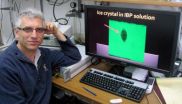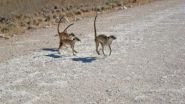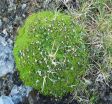(Press-News.org) New research has revealed that immature malaria parasites are more resistant to treatment with key antimalarial drugs than older parasites, a finding that could lead to more effective treatments for a disease that kills one person every minute and is developing resistance to drugs at an alarming rate.
University of Melbourne researchers have shown for the first time that malaria parasites (Plasmodium falciparum)in the early stages of development are more than 100 times less sensitive to artemisinin-based drugs, which currently represent a last line of defense against malaria.
The study was conducted by a team led by Professor Leann Tilley and Dr Nectarios (Nick) Klonis from the Department of Biochemistry and Molecular Biology and the Bio21 Institute, and is published in the journal PNAS.
The drug artemisinin (ART) saves millions of lives each year but it is still not clear exactly how it works. Professor Tilley's team developed a novel approach to examine how the parasite responds to drugs under the conditions it encounters in the body. This is important because the malaria parasite takes two days to reach maturity in each cycle but the drug only remains in the bloodstream for a few hours.
"We were surprised to find that juvenile parasites were up to 100 times less sensitive to the drug than mature parasites, and that in some strains the juvenile parasites showed a particularly high degree of resistance. This would result in a large number of juvenile parasites surviving against clinical treatment and helps explain how resistance to drugs develops," Professor Tilley said.
In order to survive in the human body, the parasite must inhabit red blood cells for part of its life cycle, to do this it first digests the cell contents including the haemoglobin protein which carries oxygen in blood.
"We found that the parasite is most susceptible to drug treatment when it is digesting haemoglobin, suggesting that a breakdown product, possibly the haemoglobin pigment, is activating ART to unleash its killing properties," Dr Klonis said.
The possibility of lower drug sensitivity of juvenile parasites was first suspected when the team studied the parasite's digestive system using a revolutionary 3D imaging technique called electron tomography at the Bio21 Institute, University of Melbourne. This initial work was supported by the ARC Centre of Excellence for Coherent X-ray Science.
"In juvenile stages the parasite's digestive system is not yet active, which explains how this stage can avoid the effects of the drug," Professor Tilley said.
"We hope that our findings will provide a guide for changing the timing of the drug treatment regime and developing longer lasting drugs, thereby killing more of the parasites and reducing the development of drug resistance."
The next steps for the team are to try and establish why certain strains are more resistant to ART drug attack than others.
"With the current political will in malaria-affected countries to combat the disease, and funding for implementation of anti-malarial strategies available from the NHMRC, Gates Foundation and other donors, the basic research being done in Australia will be quickly translated into lives saved in the field," added Professor Tilley.
INFORMATION:
Images of the parasite life cycle are available on request.
For more information:
Professor Leann Tilley, T: +61 3 8344 2227; M: 0409 847 281; E:ltilley@unimelb.edu.au
Dr Nerissa Hannink (media office), T: +61 3 8344 8151; M: 0430 588 055; E:nhannink@unimelb.edu.au
Young malaria parasites refuse to take their medicine, may explain emerging drug resistance
2013-02-19
ELSE PRESS RELEASES FROM THIS DATE:
Some cheeses exceed contaminant levels recommended by EU
2013-02-19
Researchers at the University of Las Palmas de Gran Canaria (Spain) have analysed more than 60 brands of cheese commonly available in supermarkets. The concentration of organochloride contaminants in the majority of the samples was lower than levels set by European legislation, but in a few cases it was higher. The scientists recommend that an eye is kept on polychlorinated biphenyls as they are carcinogenic. The majority of these compound concentrations appeared in organic cheeses.
"In general, chloride contaminant residue levels were low in the cheese samples that we ...
Gene linked to worse outcomes for melanoma
2013-02-19
Scientists at Queen Mary, University of London have identified a gene present in some melanoma which appears to make the tumour cells more resistant to treatment, according to research published today in the Journal of Experimental Medicine.
The scientists discovered that the gene TP63 is unexpectedly expressed in some melanoma and correlates significantly with a worse prognosis. It is hoped this new understanding of what makes some melanoma cells so difficult to kill will help inform the development of new therapies.
Melanoma is a form of skin cancer which usually appears ...
Not just cars, but living organisms need antifreeze to survive
2013-02-19
Jerusalem, February 17, 2013 – If you thought antifreeze was only something that was necessary to keep your car from freezing up in the winter, think again. Plants and animals living in cold climates have natural antifreeze proteins (AFPs) which prevent ice growth and crystallization of organic fluid matter. Without such antifreeze, living matter would suffer from frost damage and even death.
Production of such antifreeze proteins is one of the major evolutionary routes taken by a variety of organisms, including fish, insects, bacteria, plants and fungi. Understanding ...
Blood is thicker than water -- and blood plasma is, too
2013-02-19
The results are significant because they can help to improve our understanding of medical conditions, such as thrombosis, aneurysms and arteriosclerosis. The research team is publishing its results in Physical Review Letters and the American Physical Society has highlighted the work on its Physics website, placing it on the Focus List of important physics news.
Blood flows differently than water. Anyone who has ever cut themselves knows that blood flows viscously and rather erratically. The similarity between blood and ketchup is something not only filmmakers are aware ...
Researchers in Manchester find genetic key to preventing spine tumors
2013-02-19
Genetic medicine experts from Manchester Biomedical Research Centre at Saint Mary's Hospital and The University of Manchester have identified a new gene responsible for causing an inherited form of tumour, known as spinal meningioma.
Professor Richard Marias, Director of the Paterson Institute
Meningiomas are the commonest form of tumour affecting the brain and spine. Usually meningiomas can be removed by surgery and do not recur. Occasionally people can develop more than one meningioma or many members of the same family can be affected.
A team led by Dr Miriam Smith, ...
Subordinate animals as guinea pigs
2013-02-19
In their environment, wild animals are exposed to countless threats, be they predators, diseases or natural obstacles to get over, such as gorges or rivers. In the course of evolution, they have developed specific behavioural responses to allow them to deal with these risks. In recent times, numerous man-made threats have been added to the naturally-existing ones, such as dangerous roads to cross. On the evolutionary time scale, it is excluded that the animals have evolved a whole new repertoire of adaptive responses to these risks. Simon Townsend is a behavioural biologist ...
Reduced sea ice disturbs balance of greenhouse gases
2013-02-19
The widespread reduction in Arctic sea ice is causing significant changes to the balance of greenhouse gases in the atmosphere. This is shown in a new study conducted by researchers from Lund University in Sweden, among others.
According to the study, the melting of sea ice in the Arctic has a tangible impact on the balance of greenhouse gases in this region, both in terms of uptake and release. The researchers have studied the greenhouse gases carbon dioxide and methane both in the tundra and in the Arctic Ocean.
"Changes in the balance of greenhouse gases can have ...
The criteria for weight-loss surgery need to be changed
2013-02-19
Weight-loss surgery is currently only offered to patients who exceed a certain BMI. However, surgical intervention could improve the health of many more people. This is shown by the Swedish Obese Subjects study carried out at the Sahlgrenska Academy, University of Gothenburg, Sweden, involving 104 patients who were operated on despite their BMI being "too low". As a result, the risk of developing diabetes was reduced by 67 percent.
In order to meet the current selection criteria for weight-loss surgery, Swedish patients must have a body mass index (BMI) above 40 for ...
Cushion plants help other plants survive
2013-02-19
Alpine cushion plants help other plants in harsh mountain environments to survive. This is shown by new research involving researchers from the University of Gothenburg, the results of which are now being publishing in the highly respected journal Ecology Letters.
Cushion plants are a type of plant found in areas such as Arctic environments, and are characterised by their distinctive, round, cushion-like shape.
A new study highlights the strong interaction between cushion plants and other plants in the most severe of mountain environments.
"Cushion plants create additional ...
New projections of 'uneven' global sea-level rise
2013-02-19
Sophisticated computer modelling has shown how sea-level rise over the coming century could affect some regions far more than others. The model shows that parts of the Pacific will see the highest rates of rise while some polar regions will actually experience falls in relative sea levels due to the ways sea, land and ice interact globally.
Reporting in the journal Geophysical Research Letters researchers have looked ahead to the year 2100 to show how ice loss will continue to add to rising sea levels. Scientists have known for some time that sea level rise around the ...





